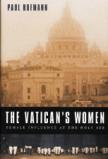She Said, She Said
If you are interested in the Vatican and its workings, you will find this a good read. Paul Hofmann, Austrian by birth, was for 35 years a foreign correspondent for The New York Times and for some of those years chief of its Rome bureau. He currently lives in Rome and has been an acute observer of the scene from the very beginning and, judging from this book, an accurate and judicious reporter of it.
The primary focus of this book is the women who work for the Vatican or are in some official or unofficial way related to it. It’s a topic that could easily be cheapened, but he resists the temptation. Even when occasionally relating some lurid incidents, he seems to have his information straight, carefully distinguishing gossip from ascertained fact. He begins with some historical background—the legend of Pope Joan, the diplomatic activities of Catherine of Siena, the strange career of Lucretia Borgia, daughter of Pope Alexander VI. He devotes a full chapter to Mother Pascalina, who looked after the domestic affairs of Pius XII from his days in Germany until his death as pope. Hofmann knew her, interviewed her and seems genuinely to have liked her.
In other chapters he describes the positions women hold today in the employ of the Vatican itself or of cardinals and other members of the Curia. He has listened to them carefully and reports credibly on their job satisfaction or lack of it, providing a number of case studies. He ranges beyond women who are full time at the Vatican to others who from greater or lesser distance have had an impact, such as Mother Teresa from India and Professor Margherita Guarducci, the Roman archeologist. For me it all rings true.
While telling the story of these women, Hofmann provides background on how the Vatican conducts its operation. There are informative sections on the Vatican Radio, Opus Dei, the Rota, the Gregorian University and a restaurant, the Eau Vive. In describing the Swiss Guard the author recounts the murder in 1998 of its commander and his wife, and he cannot resist telling about Archbishop Milingo and his bride. Somehow these and other pieces fit into his account and do not deviate too much from what his title promises.
The back cover describes the book as groundbreaking. It is not. For persons unfamiliar with Rome, it provides reliable information and will, I am sure, correct some misconceptions. For those familiar with Rome, like myself, it provides little they would not already know or suspect. Even they, however, will find the book interesting and be impressed by the substance Hofmann provides for what otherwise would remain impressions. I picked it up intending to give it a good skim. I ended up reading every word.
This article also appeared in print, under the headline “She Said, She Said,” in the October 14, 2002, issue.








